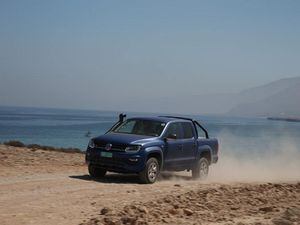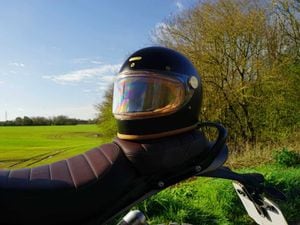Arabian Nights and Days with the Volkswagen Amarok in Oman
The Volkswagen Amarok is one of the most car-like pick-ups on the market today, but can it still deal with a proper off-road challenge? Jack Evans heads to Oman to find out

Picture the scene: There’s a two-tonne pick-up lodged in sand up to its axles, wheels spinning furiously while two people attempt to push it free. Welcome to Oman: The home of rocky valleys, dried-out riverbeds and – as we found – extremely deep sand dunes.
But let’s take things back a little bit. Volkswagen wanted to showcase just what its Amarok pick-up – now featuring an even more powerful diesel engine – could do on some seriously difficult terrain, and this, as it happens, is what you find in Oman.
Day one would see us introduced to our trucks. Now, any pick-up looks good with plenty of off-road kit fitted to it, but the Amarok was particularly exceptional. A snorkel, raised suspension and chunky all-surface tyres had been fitted to make the big Volkswagen more capable on awkward surfaces – and in truth it made the vehicle look seriously good.

Our first route would take in mostly motorways before leading up away from the sea at Fins and into the mountains. If you thought the UK was a hotbed for speed cameras, you need to go to Oman. There’s a speed trap nearly every few miles on the motorway, and this means you’re always pretty cautious about how quickly you’re going. Driving out of Muscat was certainly a wake-up call, particularly considering the overnight flight we’d just alighted from, with horns blaring and the occasional Toyota Land Cruiser cutting us up.
The route quickly spikes up, heading into the Hajar Mountains. On tarmac, the Amarok remains predictably well refined, but it’s on the loose gravel and dust of the mountain roads where it really shines. It manages to shimmy around and let you know that the surface is a little unstable, but it never feels like it’s out of control.

As we arrived at the Salmah Plateau – our stopover point for the night – we were handed a pop-up tent, a sleeping bag and told to pick a rock-free spot on the ground. The surface was too hard to drive tent pegs into, so we ended up weighing the tents down with large boulders from nearby. Rough and ready, that’s for sure, but it certainly reflected the ethos of the Amarok. And as the sun set on the nearby Jaylah Tower Tombs – brick structures dating back to the early Bronze Age – you really wouldn’t have wanted it any other way.
Our next day’s driving would see us push further south into the country, heading towards the 1,000 Nights Camp in the middle of the desert.
The route was fringed at many points by wadis. These dried-out river beds are large and wide, and created by frequent torrents gushing down the mountains after heavy rainfall. We stop briefly in the middle of one – the combination of ridged, deposited sand and little shade under the baking hot sun making you feel like you’re sitting on a griddle pan – as a guide tells us how many unsuspecting drivers leave their cars in the wadis and return after it’s rained to find them completely washed away. Needless to say, we hurry onwards shortly afterwards.

After a quick stopover at midday we mount up once more and head towards the desert. Stopping at the small town of Al Mintarib on the outskirts, we drop the air pressure in the tyres. Lower tyres, after all, make for better traction on sand.
As we head out of the town, the tarmac quickly drops away and gives way to sand – lots and lots of sand.
Now, I’ll happily admit that I haven’t driven on sand before. Snow? Yes. Gravel? Forget about it. Sand, however, proved to be a new challenge.

Driving up the first incline, I got stuck. Wheels spinning, sending sand up into the air, there was little I could do to get moving. Thankfully, though, with a bit of pushing from some others in the group, I managed to get free.
After a few more successful dunes, a steeper incline appeared. I’d learnt by now that the best option was to hit the deeper sections as hard as possible – speed is a bit of an ally when it comes to sand driving, apparently.
Thankfully, the approach worked and the truck flew up the slope with little effort, though a large bump in the middle was – according to those stood watching – a result of the truck taking off from the ground. Maybe a little too much speed then…

At the top of the hill I leave the truck to have a look at the remaining Amaroks attempting the climb. Most make it to the top and move onwards, but some reach the summit and then immediately get stuck. Many get properly beached, and it takes a few hours to move them out.
By the time all the trucks are freed it’s dark. Thankfully, our overnight stopover is in the middle of the dunes. The 1,000 Nights Camp proves to be the ideal place to park up after a long day.

The next day sees us rolling back to Muscat. The route takes in long, dusty trails that snake through the desert towards Al Mintarib. There, we reinflate the tyres and hit the tarmac. After driving on sand for so long, firm ground seems strange – you’re almost expecting it to shift around underneath you.
Arriving at our final hotel, I say goodbye to ‘my’ Amarok. With hundreds of miles covered and many difficult conditions conquered, it was a hard farewell. However, the big Volkswagen more than proved its worth, and showed that despite being comfortable and refined, it can more than take on the rough stuff.





